Field-Scale Evaluation of the Soil Quality Index as Influenced by Dairy Manure and Inorganic Fertilizers
Abstract
:1. Introduction
2. Materials and Methods
2.1. Study Area, Treatments and Dairy Manure Characteristics
2.2. Data Collection, Sampling and Soil Quality Index Indicators Analysis
2.3. Soil Quality Index Assessments
2.4. Data Analysis
2.5. Spatial Evaluation and Mapping
3. Results
3.1. Soil Properties and Pearson’s Correlation Analysis
3.2. Soil Quality Index Assessment and Spatial Distribution
3.3. Crop Yield and Global Warming Potential
4. Discussion
4.1. The Interactions among Individual Soil Properties
4.2. Soil Quality Assessment under Manure and Inorganic Fertilizer Applications
4.3. Soil Quality, Crop Yield and Global Warming Potential
5. Conclusions
Author Contributions
Funding
Acknowledgments
Conflicts of Interest
References
- Shahid, M.; Shukla, A.K.; Bhattacharyya, P.; Tripathi, R.; Mohanty, S.; Kumar, A.; Lal, B.; Gautam, P.; Raja, R.; Panda, B.B.; et al. Micronutrients (Fe, Mn, Zn and Cu) balance under long-term application of fertilizer and manure in a tropical rice-rice system. J. Soils Sediments 2015, 16, 737–747. [Google Scholar] [CrossRef]
- Ghosh, B.N.; Meena, V.S.; Singh, R.J.; Alam, N.; Patra, S.; Bhattacharyya, R.; Sharma, N.; Dadhwal, K.; Mishra, P. Effects of fertilization on soil aggregation, carbon distribution and carbon management index of maize-wheat rotation in the north-western Indian Himalayas. Ecol. Indic. 2019, 105, 415–424. [Google Scholar] [CrossRef]
- Paz-Kagan, T.; Zaady, E.; Salbach, C.; Schmidt, A.; Lausch, A.; Zacharias, S.; Notesco, G.; Ben-Dor, E.; Karnieli, A. Mapping the Spectral Soil Quality Index (SSQI) Using Airborne Imaging Spectroscopy. Remote Sens. 2015, 7, 15748–15781. [Google Scholar] [CrossRef] [Green Version]
- Andrews, S.S.; Karlen, D.L.; Mitchell, J.P. A comparison of soil quality indexing methods for vegetable production systems in Northern California. Agric. Ecosyst. Environ. 2002, 90, 25–45. [Google Scholar] [CrossRef]
- Li, G.; Chen, J.; Sun, Z.; Tan, M. Establishing a minimum dataset for soil quality assessment based on soil properties and land-use changes. Acta Ecol. Sin. 2007, 27, 2715–2724. [Google Scholar] [CrossRef]
- De Laurentiis, V.; Secchi, M.; Bos, U.; Horn, R.; Laurent, A.; Sala, S. Soil quality index: Exploring options for a comprehensive assessment of land use impacts in LCA. J. Clean. Prod. 2018, 215, 63–74. [Google Scholar] [CrossRef]
- Favrot, J.-C.; Lagacherie, P. La cartographie automatisee des sols: Une aide a la gestion ecologique des paysages ruraux. C. R. Acad. Agric. Fr. 1993, 79, 61–76. [Google Scholar]
- McBratney, A.B.; Odeh, I.O.A.; Bishop, T.F.A.; Dunbar, M.S.; Shatar, T.M. An Overview of Pedometric Techniques for Use in Soil Survey. Geoderma 2000, 97, 293–327. [Google Scholar] [CrossRef]
- McBratney, A.B.; Mendonça Santos, M.L.; Minasny, B. On digital soil mapping. Geoderma 2003, 117, 3–52. [Google Scholar] [CrossRef]
- Ozlu, E. Long-Term Impacts of Annual Cattle Manure and Fertilizer on Soil Quality under Corn-Soybean Rotation in Eastern South Dakota; South Dakota State University: Brookings, SD, USA, 2016. [Google Scholar]
- Ozlu, E.; Sandhu, S.S.; Kumar, S.; Arriaga, F.J. Soil health indicators impacted by long-term cattle manure and inorganic fertilizer application in a corn-soybean rotation of South Dakota. Sci. Rep. 2019, 9, 11776. [Google Scholar] [CrossRef] [Green Version]
- Mulder, V.; De Bruin, S.; Schaepman, M.; Mayr, T. The use of remote sensing in soil and terrain mapping—A review. Geoderma 2011, 162, 1–19. [Google Scholar] [CrossRef]
- Ozlu, E.; Kumar, S. Response of soil organic carbon, pH, electrical conductivity, and water stable aggregates to long-term annual manure and inorganic fertilizer. Soil Sci. Soc. Am. J. 2018, 82, 1243–1251. [Google Scholar] [CrossRef]
- Ozlu, E.; Kumar, S.; Arriaga, F.J. Responses of Long-Term Cattle Manure on Soil Physical and Hydraulic Properties under a Corn-Soybean Rotation at Two Locations in Eastern South Dakota. Soil Sci. Soc. Am. J. 2019, 83, 1459–1467. [Google Scholar] [CrossRef]
- Ozlu, E.; Kumar, S. Response of surface GHG fluxes to long-term manure and inorganic fertilizer application in corn and soybean rotation. Sci. Total Environ. 2018, 626, 817–825. [Google Scholar] [CrossRef] [PubMed]
- Grossman, R.; Reinsch, T. 2.1 Bulk density and linear extensibility. Methods Soil Anal. Part 4 Phys. Methods 2002, 5, 201–228. [Google Scholar]
- Kemper, W.; Rosenau, R. Aggregate stability and size distribution. Methods Soil Anal. Part 1 Phys. Mineral. Methods 1986, 5, 425–442. [Google Scholar]
- Klute, A.; Dirksen, C. Hydraulic conductivity and diffusivity: Laboratory methods. Methods Soil Anal. Part 1 Phys. Mineral. Methods 1986, 5, 687–734. [Google Scholar]
- Stetson, S.J.; Osborne, S.L.; Schumacher, T.E.; Eynard, A.; Chilom, G.; Rice, J.; Nichols, K.A.; Pikul, J.L., Jr. Corn residue removal impact on topsoil organic carbon in a corn–soybean rotation. Soil Sci. Soc. Am. J. 2012, 76, 1399–1406. [Google Scholar] [CrossRef]
- Silveira, M.; Comerford, N.; Reddy, K.; Cooper, W.; El-Rifai, H. Characterization of soil organic carbon pools by acid hydrolysis. Geoderma 2008, 144, 405–414. [Google Scholar] [CrossRef]
- Frostegård, A.; Tunlid, A.; Bååth, E. Phospholipid Fatty Acid Composition, Biomass, and Activity of Microbial Communities from Two Soil Types Experimentally Exposed to Different Heavy Metals. Appl. Environ. Microbiol. 1993, 59, 3605–3617. [Google Scholar] [CrossRef] [Green Version]
- Dick, R.P. Methods of Soil Enzymology; Soil Science Society of America: Madison, WI, USA, 2011. [Google Scholar]
- Armenise, E.; Redmile-Gordon, M.; Stellacci, A.M.; Ciccarese, A.; Rubino, P. Developing a soil quality index to compare soil fitness for agricultural use under different managements in the Mediterranean environment. Soil Tillage Res. 2013, 130, 91–98. [Google Scholar] [CrossRef]
- Brejda, J.J.; Moorman, T.B.; Karlen, D.L.; Dao, T.H. Identification of Regional Soil Quality Factors and Indicators I. Central and Southern High Plains. Soil Sci. Soc. Am. J. 2000, 64, 2115–2124. [Google Scholar] [CrossRef]
- Wander, M.M.; Bollero, G.A. Soil Quality Assessment of Tillage Impacts in Illinois. Soil Sci. Soc. Am. J. 1999, 63, 961–971. [Google Scholar] [CrossRef]
- Waswa, B.S.; Vlek, P.L.; Tamene, L.D.; Okoth, P.; Mbakaya, D.; Zingore, S. Evaluating indicators of land degradation in smallholder farming systems of western Kenya. Geoderma 2013, 195, 192–200. [Google Scholar] [CrossRef]
- Raiesi, F.; Kabiri, V. Identification of soil quality indicators for assessing the effect of different tillage practices through a soil quality index in a semi-arid environment. Ecol. Indic. 2016, 71, 198–207. [Google Scholar] [CrossRef]
- Nabiollahi, K.; Golmohamadi, F.; Taghizadeh, R.; Kerry, R.; Davari, M. Assessing the effects of slope gradient and land use change on soil quality degradation through digital mapping of soil quality indices and soil loss rate. Geoderma 2018, 318, 16–28. [Google Scholar] [CrossRef]
- Vasu, D.; Singh, S.K.; Ray, S.K.; Duraisami, V.P.; Tiwary, P.; Chandran, P.; Nimkar, A.M.; Anantwar, S.G. Soil quality index (SQI) as a tool to evaluate crop productivity in semi-arid Deccan plateau, India. Geoderma 2016, 282, 70–79. [Google Scholar] [CrossRef]
- Andrews, S.S.; Carroll, C.R. Designing a soil quality assessment tool for sustainable agroecosystem management. Ecol. Appl. 2001, 11, 1573–1585. [Google Scholar] [CrossRef]
- Karlen, D.; Wollenhaupt, N.; Erbach, D.; Berry, E.; Swan, J.; Eash, N.; Jordahl, J. Crop residue effects on soil quality following 10-years of no-till corn. Soil Tillage Res. 1994, 31, 149–167. [Google Scholar] [CrossRef]
- Goovaerts, P. Geostatistics for Natural Resources Evaluation; Oxford University Press: New York, NY, USA, 1997; pp. 47–56. [Google Scholar]
- Marschner, H. Marschner’s Mineral Nutrition of Higher Plants, 3rd ed.; Academic Press: Cambridge, MA, USA, 2011; pp. 135–150. [Google Scholar]
- Linn, D.M.; Doran, J.W. Effect of Water-Filled Pore Space on Carbon Dioxide and Nitrous Oxide Production in Tilled and Nontilled Soils. Soil Sci. Soc. Am. J. 1984, 48, 1267–1272. [Google Scholar] [CrossRef] [Green Version]
- Torbert, H.; Wood, C. Effects of soil compaction and water-filled pore space on soil microbial activity and N losses. Commun. Soil Sci. Plant Anal. 1992, 23, 1321–1331. [Google Scholar] [CrossRef]
- Du, Y.; Cui, B.; Zhang, Q.; Wang, Z.; Sun, J.; Niu, W. Effects of manure fertilizer on crop yield and soil properties in China: A meta-analysis. CATENA 2020, 193, 104617. [Google Scholar] [CrossRef]
- Jehan, S.; Iqbal, M.; Zahir, Z.A.; Farooq, M. Role of dairy manure in improving wheat yield under deficit irrigation. Pak. J. Bot. 2020, 52, 639–644. [Google Scholar] [CrossRef]
- Eghball, B. Liming effects of beef cattle feedlot manure or compost. Commun. Soil Sci. Plant Anal. 1999, 30, 2563–2570. [Google Scholar] [CrossRef]
- Yagi, R.; Ferreira, M.E.; Cruz, M.C.P.D.; Barbosa, J.C. Organic matter fractions and soil fertility under the influence of liming, vermicompost and cattle manure. Sci. Agric. 2003, 60, 549–557. [Google Scholar] [CrossRef]
- Ning, Q.; Chen, L.; Jia, Z.; Zhang, C.; Ma, D.; Li, F.; Zhang, J.; Li, D.; Han, X.; Cai, Z. Multiple long-term observations reveal a strategy for soil pH-dependent fertilization and fungal communities in support of agricultural production. Agric. Ecosyst. Environ. 2020, 293, 106837. [Google Scholar] [CrossRef]
- Ozlu, E.; Arriaga, F.J. The role of carbon stabilization and minerals on soil aggregation in different ecosystems. CATENA 2021, 202, 105303. [Google Scholar] [CrossRef]
- Jansa, J.; Mozafar, A.; Kuhn, G.; Anken, T.; Ruh, R.; Sanders, I.; Frossard, E. Soil tillage affects the community structure of mycorrhizal fungi in maize roots. Ecol. Appl. 2003, 13, 1164–1176. [Google Scholar] [CrossRef] [Green Version]
- Krauss, M.; Berner, A.; Perrochet, F.; Frei, R.; Niggli, U.; Mäder, P. Enhanced soil quality with reduced tillage and solid manures in organic farming—A synthesis of 15 years. Sci. Rep. 2020, 10, 4403. [Google Scholar] [CrossRef] [Green Version]
- Liu, Z.; Zhou, W.; Shen, J.; Li, S.; Ai, C. Soil quality assessment of yellow clayey paddy soils with different productivity. Biol. Fertil. Soils 2013, 50, 537–548. [Google Scholar] [CrossRef]
- Tripathi, R.; Shukla, A.; Shahid, M.; Nayak, D.; Puree, C.; Mohanty, S.; Raja, R.; Lal, B.; Gautam, P.; Bhattacharyya, P.; et al. Soil quality in mangrove ecosystem deteriorates due to rice cultivation. Ecol. Eng. 2016, 90, 163–169. [Google Scholar] [CrossRef]
- Zhang, Q.-C.; Shamsi, I.H.; Xu, D.-T.; Wang, G.-H.; Lin, X.-Y.; Jilani, G.; Hussain, N.; Chaudhry, A.N. Chemical fertilizer and organic manure inputs in soil exhibit a vice versa pattern of microbial community structure. Appl. Soil Ecol. 2012, 57, 1–8. [Google Scholar] [CrossRef]
- DAS, B.; Chakraborty, D.; Singh, V.K.; Ahmed, M.; Singh, A.K.; Barman, A. Evaluating Fertilization Effects on Soil Physical Properties Using a Soil Quality Index in an Intensive Rice-Wheat Cropping System. Pedosphere 2016, 26, 887–894. [Google Scholar] [CrossRef]
- Liu, Z.; Rong, Q.; Zhou, W.; Liang, G. Effects of inorganic and organic amendment on soil chemical properties, enzyme activities, microbial community and soil quality in yellow clayey soil. PLoS ONE 2017, 12, e0172767. [Google Scholar] [CrossRef] [PubMed]
- Zhou, M.; Xiao, Y.; Li, Y.; Zhang, X.; Wang, G.; Jin, J.; Ding, G.; Liu, X. Soil quality index evaluation model in responses to six-year fertilization practices in Mollisols. Arch. Agron. Soil Sci. 2020, 68, 180–194. [Google Scholar] [CrossRef]
- Karlen, D.L.; Mausbach, M.J.; Doran, J.W.; Cline, R.G.; Harris, R.F.; Schuman, G.E. Soil Quality: A Concept, Definition, and Framework for Evaluation (A Guest Editorial). Soil Sci. Soc. Am. J. 1997, 61, 4–10. [Google Scholar] [CrossRef] [Green Version]
- Cherubin, M.R.; Eitelwein, M.T.; Fabbris, C.; Weirich, S.W.; Da Silva, R.F.; Da Silva, V.R.; Basso, C.J. Physical, chemical, and biological quality in an Oxisol under different tillage and fertilizer sources. Rev. Bras. Ciênc. Solo 2015, 39, 615–625. [Google Scholar] [CrossRef] [Green Version]
- Şenol, H.; Alaboz, P.; Demir, S.; Dengiz, O. Computational intelligence applied to soil quality index using GIS and geostatistical approaches in semiarid ecosystem. Arab. J. Geosci. 2020, 13, 1235. [Google Scholar] [CrossRef]
- Lee, C.-H.; Wu, M.-Y.; Asio, V.B.; Chen, Z.-S. Using a soil quality index to assess the effects of applying swine manure compost on soil quality under a crop rotation system in Taiwan. Soil Sci. 2006, 171, 210–222. [Google Scholar] [CrossRef] [Green Version]
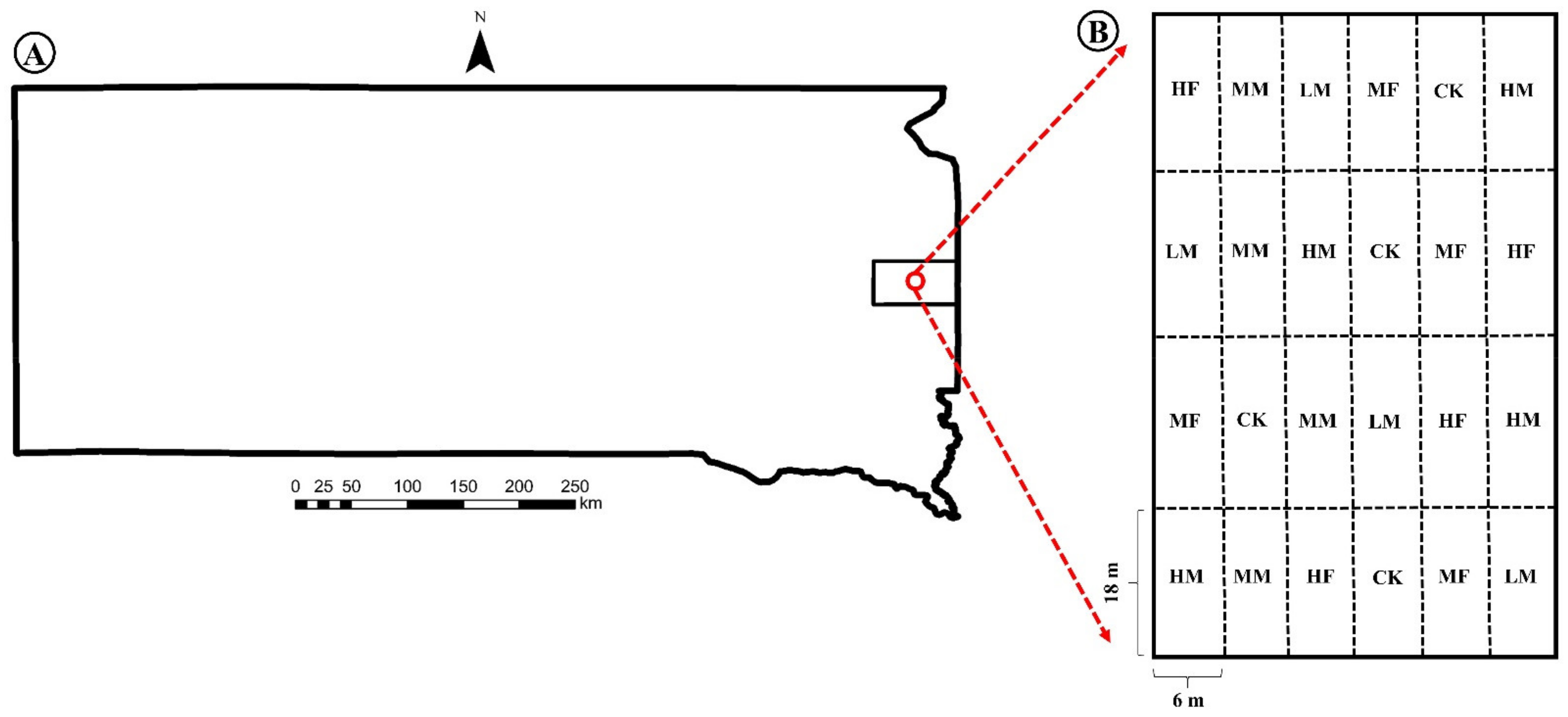
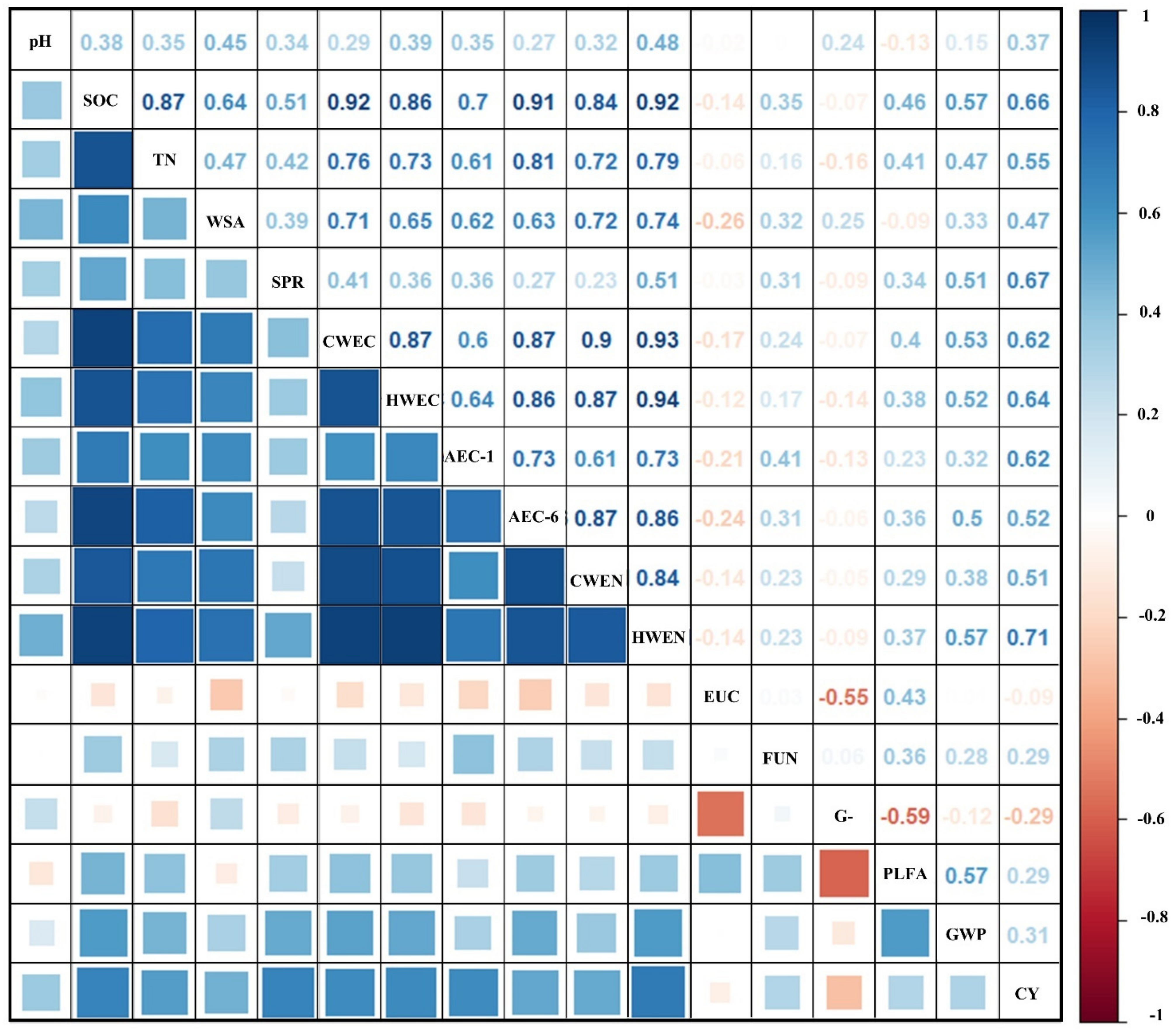
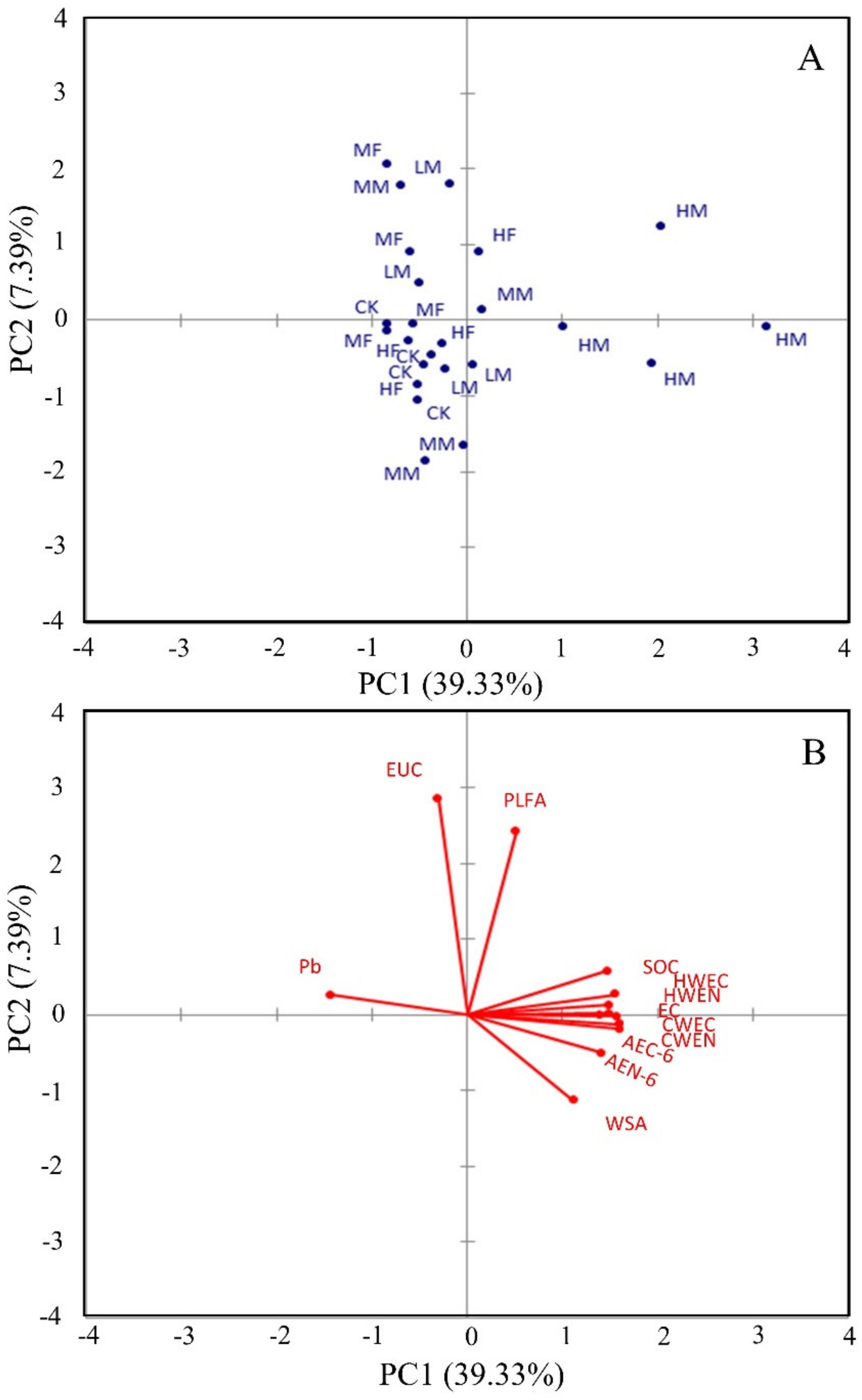
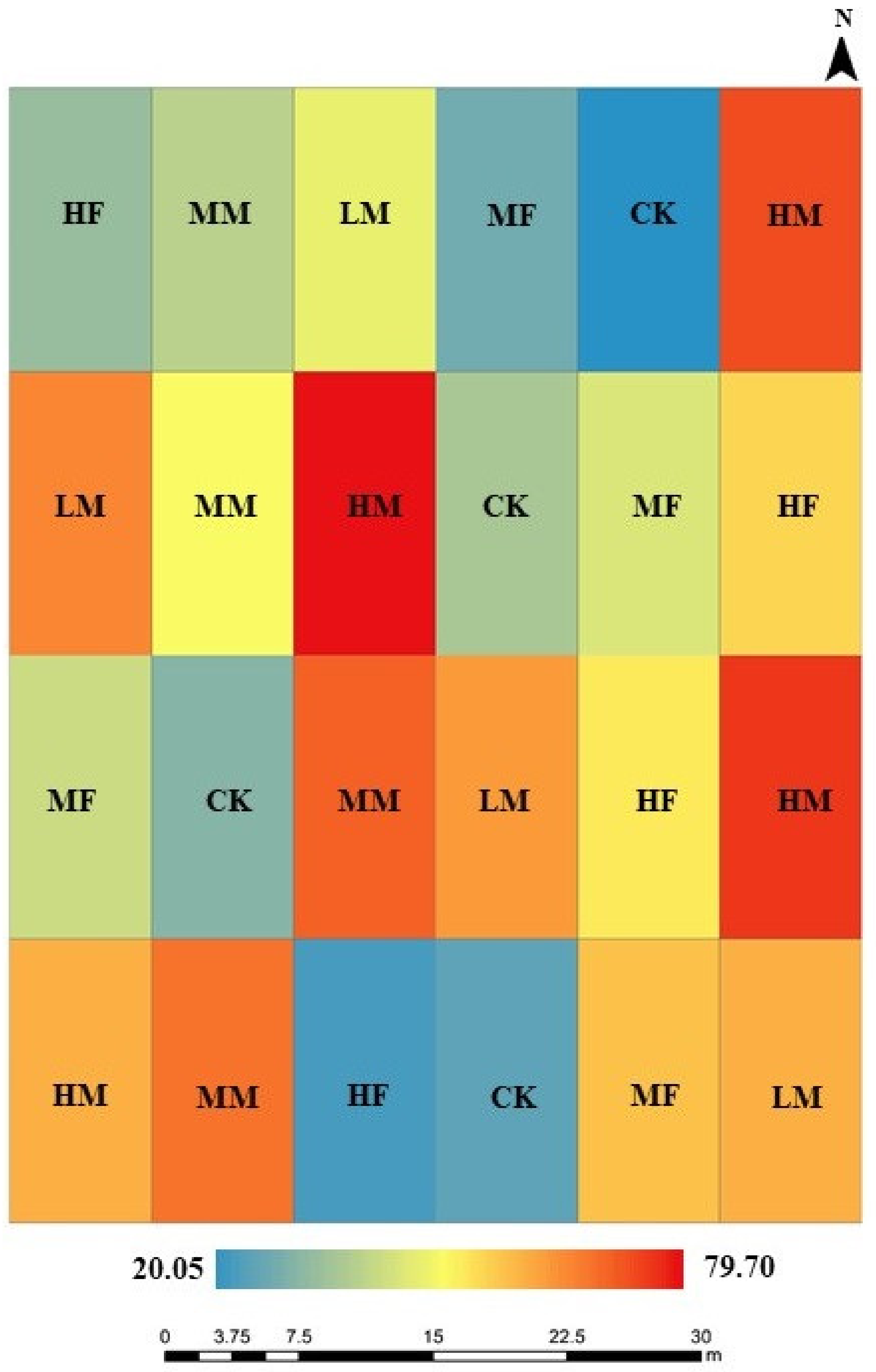
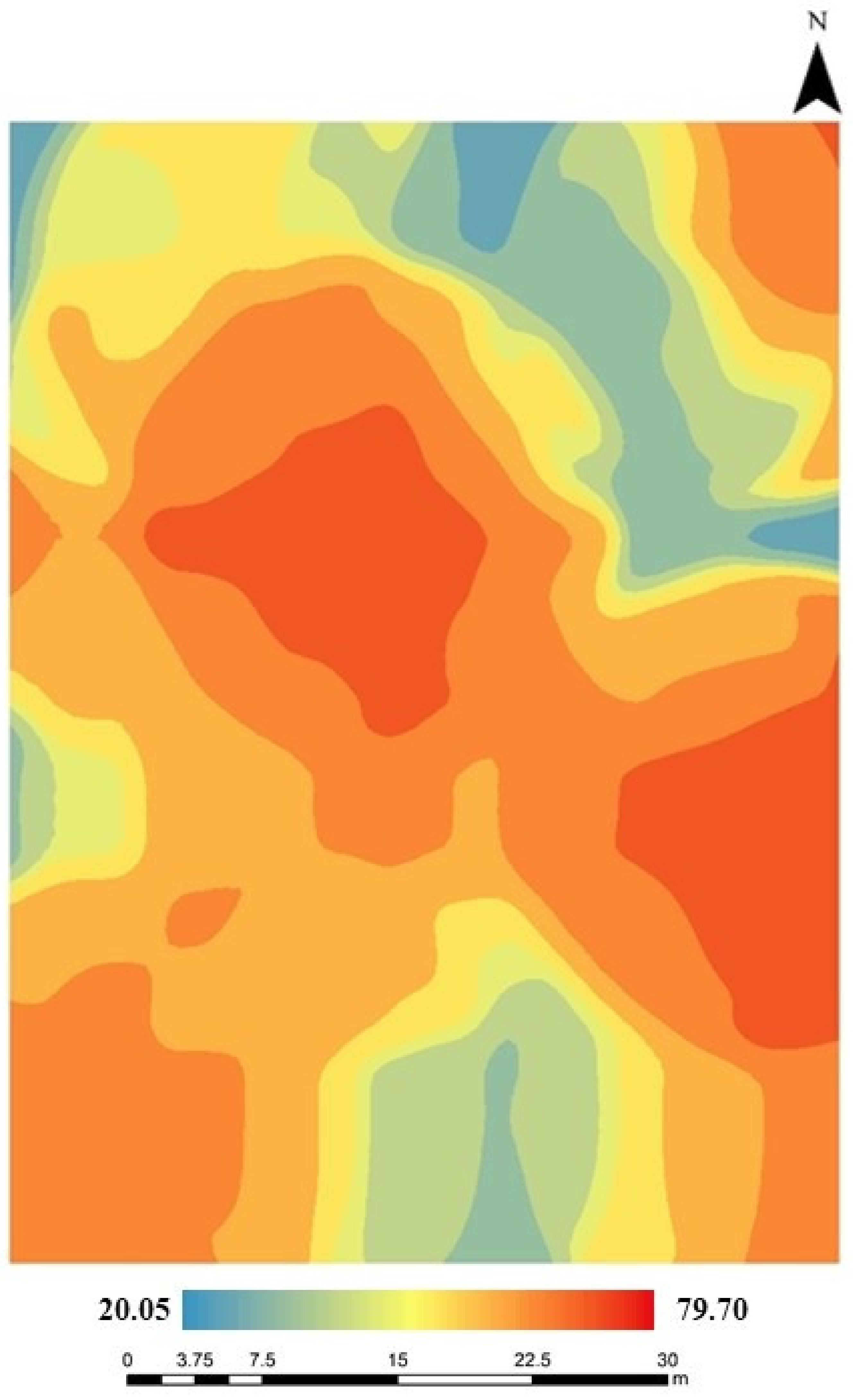
| Property | Mean | p-Value | |||||
|---|---|---|---|---|---|---|---|
| LM † | MM | HM | HF | MF | CK | ||
| pH | 6.91 ‡ | 6.90 | 7.05 | 6.38 | 6.66 | 6.86 | <0.01 |
| EC | 1.15 | 1.51 | 2.01 | 0.66 | 0.75 | 0.72 | <0.01 |
| SOC | 27.6 | 30.9 | 38.3 | 25.8 | 24.0 | 23.3 | <0.01 |
| TN | 2.52 | 2.80 | 3.45 | 2.64 | 2.30 | 2.24 | <0.01 |
| WSA | 91.9 | 93.5 | 98.6 | 87.4 | 89.2 | 90.1 | 0.01 |
| Pb | 1.13 | 1.07 | 0.87 | 1.23 | 1.22 | 1.20 | <0.01 |
| SPR | 311 | 365 | 335 | 312 | 302 | 285 | 0.1 |
| WC300 | 0.50 | 0.53 | 0.51 | 0.42 | 0.43 | 0.45 | <0.01 |
| CWEC | 0.14 | 0.15 | 0.31 | 0.12 | 0.09 | 0.08 | <0.01 |
| HWEC | 0.75 | 0.70 | 1.14 | 0.64 | 0.61 | 0.52 | <0.01 |
| AEC-1 | 9.12 | 9.92 | 9.88 | 7.72 | 7.62 | 7.63 | 0.01 |
| AEC-6 | 8.56 | 8.93 | 11.00 | 8.19 | 7.68 | 7.69 | 0.01 |
| CWEN | 0.04 | 0.04 | 0.09 | 0.03 | 0.03 | 0.03 | <0.01 |
| HWEN | 0.12 | 0.12 | 0.19 | 0.09 | 0.08 | 0.07 | <0.01 |
| AEN-1 | 1.73 | 1.89 | 1.94 | 1.47 | 1.50 | 1.45 | 0.02 |
| AEN-6 | 1.79 | 1.94 | 2.38 | 1.78 | 1.73 | 1.66 | 0.01 |
| EUC | 9.17 | 6.86 | 7.28 | 6.79 | 10.94 | 6.49 | 0.01 |
| AMF | 3.28 | 4.50 | 4.93 | 3.70 | 3.40 | 2.65 | 0.04 |
| FUN | 4.74 | 5.90 | 5.17 | 3.82 | 4.91 | 4.10 | 0.05 |
| G- | 46.7 | 47.9 | 48.5 | 45.0 | 43.7 | 58.2 | 0.5 |
| G+ | 18.8 | 18.0 | 18.3 | 21.0 | 17.2 | 12.7 | 0.06 |
| ACT | 14.4 | 14.3 | 13.2 | 17.0 | 17.2 | 13.3 | <0.01 |
| PLFA | 83.5 | 91.2 | 106.3 | 84.0 | 73.4 | 42.3 | 0.4 |
| UA | 23.9 | 24.4 | 24.9 | 20.5 | 20.4 | 19.7 | <0.01 |
| βA | 24.3 | 25.0 | 25.6 | 23.7 | 22.2 | 20.3 | <0.01 |
| WFPS | 51.8 | 52.8 | 47.1 | 48.5 | 54.7 | 53.4 | 0.01 |
| Property | Factor Loading ‡ | Contribution of Variables (%) # | ||||||||||
|---|---|---|---|---|---|---|---|---|---|---|---|---|
| PC1 | PC2 | PC3 | PC4 | PC5 | PC6 | PC1 | PC2 | PC3 | PC4 | PC5 | PC6 | |
| pH | 0.34 | −0.03 | 0.32 | −0.12 | 0.76 | −0.22 | 1.13 | 0.04 | 3.18 | 0.74 | 30.5 | 1.63 |
| EC | 0.81 | 0.01 | 0.41 | 0.14 | 0.26 | −0.07 | 6.42 | 0.00 | 5.28 | 0.97 | 3.48 | 0.18 |
| SOC | 0.91 | 0.08 | 0.31 | 0.17 | 0.03 | 0.06 | 8.04 | 0.34 | 2.97 | 1.56 | 0.04 | 0.12 |
| TN | 0.85 | 0.17 | 0.20 | −0.01 | −0.01 | 0.07 | 7.13 | 1.55 | 1.30 | 0.01 | 0.00 | 0.19 |
| WSA | 0.65 | −0.34 | 0.32 | 0.19 | 0.23 | −0.15 | 4.10 | 5.89 | 3.25 | 1.90 | 2.66 | 0.82 |
| Pb | −0.89 | 0.08 | −0.29 | −0.31 | 0.02 | 0.19 | 6.71 | 0.30 | 2.69 | 4.82 | 0.02 | 1.24 |
| SPR | 0.20 | 0.11 | 0.85 | 0.09 | 0.03 | 0.02 | 0.40 | 0.67 | 22.5 | 0.38 | 0.05 | 0.01 |
| WC300 | 0.32 | −0.19 | 0.49 | 0.45 | 0.54 | 0.04 | 1.00 | 1.83 | 7.40 | 10.3 | 15.2 | 0.05 |
| CWEC | 0.92 | −0.01 | 0.24 | 0.07 | −0.05 | 0.07 | 8.21 | 0.00 | 1.78 | 0.28 | 0.15 | 0.18 |
| HWEC | 0.87 | 0.04 | 0.29 | −0.03 | 0.08 | 0.13 | 7.37 | 0.08 | 2.53 | 0.04 | 0.31 | 0.60 |
| AEC-1 | 0.61 | −0.23 | 0.31 | 0.39 | 0.16 | 0.31 | 3.66 | 2.64 | 2.92 | 7.80 | 1.27 | 3.43 |
| AEC-6 | 0.93 | −0.06 | 0.08 | 0.17 | −0.03 | 0.11 | 8.46 | 0.16 | 0.18 | 1.42 | 0.03 | 0.45 |
| CWEN | 0.93 | −0.04 | 0.04 | 0.07 | 0.03 | 0.07 | 8.44 | 0.07 | 0.05 | 0.24 | 0.04 | 0.16 |
| HWEN | 0.87 | 0.01 | 0.43 | 0.03 | 0.11 | 0.08 | 7.36 | 0.00 | 5.75 | 0.05 | 0.58 | 0.22 |
| AEN-1 | 0.62 | −0.15 | 0.17 | 0.37 | 0.23 | 0.50 | 3.71 | 1.12 | 0.92 | 7.06 | 2.71 | 8.88 |
| AEN-6 | 0.82 | −0.15 | −0.07 | 0.21 | 0.07 | 0.28 | 6.63 | 1.19 | 0.14 | 2.23 | 0.25 | 2.79 |
| EUC | −0.18 | 0.84 | −0.04 | −0.03 | 0.15 | 0.13 | 0.31 | 37.0 | 0.05 | 0.03 | 1.16 | 0.59 |
| AMF | 0.51 | −0.24 | 0.20 | 0.16 | 0.01 | 0.56 | 2.50 | 3.00 | 1.25 | 1.35 | 0.00 | 10.8 |
| FUN | 0.15 | 0.12 | 0.19 | 0.90 | −0.09 | −0.12 | 0.23 | 0.79 | 1.14 | 41.4 | 0.43 | 0.47 |
| G- | −0.01 | −0.48 | −0.07 | 0.09 | 0.13 | −0.84 | 0.00 | 11.9 | 0.13 | 0.37 | 0.92 | 24.7 |
| G+ | 0.12 | 0.26 | −0.03 | −0.16 | −0.01 | 0.86 | 0.14 | 3.38 | 0.03 | 1.34 | 0.01 | 26.2 |
| ACT | −0.35 | −0.03 | 0.05 | −0.45 | −0.48 | 0.44 | 1.23 | 0.04 | 0.07 | 10.3 | 12.0 | 6.77 |
| PLFA | 0.30 | 0.72 | 0.19 | 0.28 | −0.22 | 0.32 | 0.88 | 26.9 | 1.15 | 3.98 | 2.61 | 3.67 |
| UA | 0.31 | −0.02 | 0.80 | 0.15 | 0.07 | 0.03 | 0.95 | 0.02 | 19.9 | 1.13 | 0.28 | 0.03 |
| βA | 0.54 | −0.07 | 0.63 | 0.06 | −0.04 | 0.37 | 2.84 | 0.22 | 12.2 | 0.16 | 0.10 | 4.72 |
| WFPS | −0.47 | 0.12 | −0.20 | −0.06 | 0.69 | 0.17 | 2.14 | 0.79 | 1.27 | 0.17 | 25.2 | 1.06 |
| Eig | 12.8 | 3.33 | 1.92 | 1.49 | 1.34 | 1.21 | ||||||
| Var | 39.3 | 7.39 | 12.3 | 7.5 | 7.33 | 10.9 | ||||||
| Cum | 39.3 | 46.7 | 59.0 | 66.5 | 73.9 | 84.8 | ||||||
| Indicator | Weight | Indicator | Weight |
|---|---|---|---|
| AEC-6 | 0.464 | FUN | 0.088 |
| EUC | 0.087 | pH | 0.086 |
| SPR | 0.073 | WFPS | 0.086 |
| UA | 0.073 | G+ | 0.129 |
| Treatment | SQI (%) | Crop Yield (Mg ha−1) | GWP (kg CO2-eq ha−1 yr−1) |
|---|---|---|---|
| LM | 54.8 b | 3.34 b | 258 b |
| MM | 55.8 b | 3.53 ab | 1028 b |
| HM | 69.6 a | 3.65 a | 1565 a |
| MF | 47.3 bc | 3.33 b | 93 b |
| HF | 44.9 bc | 3.40 ab | 568 b |
| CK | 36.3 †c& | 3.06 c | 91 b |
| ANOVA | <0.01 | <0.01 | 0.01 |
Publisher’s Note: MDPI stays neutral with regard to jurisdictional claims in published maps and institutional affiliations. |
© 2022 by the authors. Licensee MDPI, Basel, Switzerland. This article is an open access article distributed under the terms and conditions of the Creative Commons Attribution (CC BY) license (https://creativecommons.org/licenses/by/4.0/).
Share and Cite
Ozlu, E.; Gozukara, G.; Acar, M.; Bilen, S.; Babur, E. Field-Scale Evaluation of the Soil Quality Index as Influenced by Dairy Manure and Inorganic Fertilizers. Sustainability 2022, 14, 7593. https://doi.org/10.3390/su14137593
Ozlu E, Gozukara G, Acar M, Bilen S, Babur E. Field-Scale Evaluation of the Soil Quality Index as Influenced by Dairy Manure and Inorganic Fertilizers. Sustainability. 2022; 14(13):7593. https://doi.org/10.3390/su14137593
Chicago/Turabian StyleOzlu, Ekrem, Gafur Gozukara, Mert Acar, Serdar Bilen, and Emre Babur. 2022. "Field-Scale Evaluation of the Soil Quality Index as Influenced by Dairy Manure and Inorganic Fertilizers" Sustainability 14, no. 13: 7593. https://doi.org/10.3390/su14137593
APA StyleOzlu, E., Gozukara, G., Acar, M., Bilen, S., & Babur, E. (2022). Field-Scale Evaluation of the Soil Quality Index as Influenced by Dairy Manure and Inorganic Fertilizers. Sustainability, 14(13), 7593. https://doi.org/10.3390/su14137593









